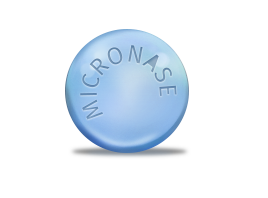 Micronase
Micronase

Micronase is used to lower blood sugar levels in people with type 2 diabetes by stimulating the release of your body's natural insulin.
- Availability: In Stock (77 packs)
- Active Ingredient: glyburide
| Package | Per Pill | Savings | Per Pack | Order |
|---|---|---|---|---|
| 90 pills | $43.47 | Buy Now | ||
| 120 pills | $0.43 | $6.58 | $57.96 $51.38 | Buy Now |
| 180 pills | $0.37 | $19.72 | $86.94 $67.22 | Buy Now |
| 360 pills | $0.32 | $59.14 | $173.88 $114.74 | Buy Now |
| Package | Per Pill | Savings | Per Pack | Order |
|---|---|---|---|---|
| 90 pills | $49.01 | Buy Now |
Micronase (Glyburide)
General information
Micronase is an anti-diabetic drug (sulfonylurea-type) that help control blood sugar levels. It is used to treat type 2 diabetes (non-insulin-dependent diabetes). It works by increasing insulin production in the pancreas and helping the body respond better to insulin. Controlling high blood sugar helps prevent kidney damage, blindness, nerve problems, loss of limbs, and sexual function problems. Proper control of diabetes may also lessen your risk of a heart attack or stroke.
Directions
Take Micronase exactly as prescribed by your doctor. The usual dose when starting the drug is 2.5 mg to 5 mg daily, taken with breakfast or the first main meal. People with kidney or liver problems or adrenal or pituitary insufficiency should start with a lower dose (1.25 mg daily). Your doctor may increase your dose. The dose can be gradually increased up to 20 mg daily. The dosage should be increased by 2.5 mg or less per week.
Precautions
Before taking Micronase you should talk with your doctor if you have kidney problems, kidney failure, liver problems, liver failure, cirrhosis, adrenal insufficiency, adrenal fatigue, pituitary gland problems, enzyme deficiency, hemolytic anemia, electrolyte imbalance (hyponatremia), nerve disorder affecting bodily functions, any allergies. You may experience blurred vision, dizziness, or drowsiness. Do not drive or perform tasks that require alertness. Limit alcohol. It can increase the risk of developing hypoglycemia. Avoid exposure to sunlight, sunlamps, or tanning beds. Micronase can make your skin more sensitive to sunlight.
Contraindications
You should not use Micronase if you are allergic to glyburide, are pregnant or breastfeeding, are being treated with bosentan, are in a state of diabetic ketoacidosis, or if you have type 1 (insulin-dependent) diabetes.
Possible side effect
Get emergency medical help if you have nausea, heartburn, stomach fullness, weight gain, loss of appetite, dark urine, bleeding, memory problems, headache, hallucinations, joint or muscle pain, blurred vision, itching, skin rash, swelling of your face, lips, tongue, difficulty breathing, hives, sore throat, fever, mental or mood changes, fainting, weakness, increased urination, rapid breathing. If you notice other effects not listed above, contact your doctor.
Drug interactions
Tell your doctor about all other medications you use, especially: antibiotics (levofloxacin, ciprofloxacin), ACE inhibitors (lisinopril, enalapril, ramipril), rifampin, antifungal medications (fluconazole, ketoconazole, itraconazole), cyclosporine, blood thinners (warfarin), beta-blockers (propranolol, metoprolol, atenolol), clonidine, albuterol, thyroid medicine (synthroid, thyroid, levothyroxine), birth control pills, heart or blood pressure medications (metoprolol, bumetanide, triamterene), seizure medicines (oxcarbazepine, topiramate, phenytoin, carbamazepine), nonsteroidal anti-inflammatory drugs (celecoxib, etodolac, naproxen, ibuprofen), monoamine oxidase inhibitors (phenelzine, tranylcypromine, isocarboxazid). Interaction between two medications does not always mean that you must stop taking one of them. Tell your doctor or prescriber about all prescription, over-the-counter, and herbal medications you are taking.
Missed dose
Take the missed dose as soon as possible. Skip the missed dose if it is time for your next scheduled dose. Don't take extra medicine to make up the missed dose.
Overdose
If you think you have overdosed the medicine seek emergency medical help at once. The overdose symptoms are weakness, blurred vision, sweating, trouble speaking, tremors, stomach pain, confusion, seizure.
Storage
Store the medicine at room temperature between 59-77 degrees F (15-25 degrees C) away from light and moisture. Do not store the drugs in the bathroom. Keep all drugs away from reach of children and pets.
Note
The information presented at the site has a general character. Note please this information cannot be used for self-treatment and self diagnosis. You should consult with your doctor or health care adviser regarding any specific instructions of your condition. The information is reliable, but we concede it could contain mistakes. We are not responsible for any direct, indirect, special or other damage caused by use of this information on the site and also for consequences of self-treatment.
 Over 1,000,000 Happy Customers
Over 1,000,000 Happy Customers
 Low Prices
Low Prices
 Fast Delivery
Fast Delivery
